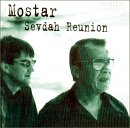Mostar Sevdah Reunion
Formerly, the singer of sevdah would accompany himself on the saz, a type of long-necked fretted lute. The music was quite loosely structured around the song; this still shows itself in the contemporary sevdah, which is most often a group effort, with the main accompanying instrument being the accordion. Unlike the guslar with his epic poems, the sevdah is based on lyrical songs. Examples can be found on Bosnia: Echoes From An Endangered World (Smithsonian Folkways), and many artists such as Safet Isovic enjoy local distribution within Bosnia.
So far as I am aware, Mostar Sevdah Reunion is the first group effort of sevdah/sevdalinke to enjoy wide international distribution, and it is well worth exploring. Not only the accordion is used, but also clarinet, violin, several basses, rhythm guitar, drums, and even an occasional electric guitar keep the musical texture fascinating (but traditional music fans should not worry about this sounding at all fusional). Iljaz Deljic' provides sinuous vocals, with notes drawn out long and as variedly beyond what one would think possible. Mustafa Santic' has the familiar Balkan accordion style which can go from soft to emphatic, light percussive ornaments to heavy drones. Santic' also plays clarinet and often trades licks with violin player Branko Petkovic, who also comes in for some high-pitched special effects. And guest vocalist Esma Redzhepova, "Queen of the Gypsies" from Macedonia, fronts the band for a lively "Moj Dilbere."
Sevdah can be sung either with or without an underlying rhythm, and on this CD, about half are without a fixed rhythm. The ones that have a fixed rhythm are based on straight rhythms, not the crooked ones present in much of Turkish-influenced music of the Balkans. However, lines are drawn out in a variety of ways (If one is familiar with the conjunto music from my state of Texas, this would be like the relationship between the very straight polka and the ranchera, which is straight like a polka, but allows the singer to take liberties with extending the musical stanza well past the usual 16 bars.) While sometimes additional measures are added, at other times there are extensions of 4/4 measures into 9/8. From both the melodic extensions in the rhythmic selections as well as the arhythmic selections, the contribution of Islamic sacred music as well as Turkish and other Middle Eastern traditions can be felt.
This is a fascinating album, half meditative, half danceable, with excellent musicianship and remarkably coherent as an artistic work. Both fans of Balkan dance music and the more brooding "Balkan blues" will find something new and delightful in this CD. I cannot recommend it too much; this is one helluva monster sevdah reunion! - Don Weeda
(Thanks to Adilagic Adis for helping me become more familiar with sevdalinke.)
Times Square Records
 The most famous music from an Islamic tradition within the former Yugoslavia may be the oral poetry of the guslar, which Albert B. Lord in his "Singer of Tales" argued came from a way of preserving memories prior to writing. But there are also significant urban Islamic musical traditions, including sevdah (or sevdalinke).
The most famous music from an Islamic tradition within the former Yugoslavia may be the oral poetry of the guslar, which Albert B. Lord in his "Singer of Tales" argued came from a way of preserving memories prior to writing. But there are also significant urban Islamic musical traditions, including sevdah (or sevdalinke).
 The CD both opens and closes with the sounds of running water. Mostar is in south Bosnia, where the famous Stari Most ('Old Bridge') divides the Muslims from the Croats in what continues to be a troubled milieu. Much of Mostar was destroyed during and after the post-pan-Yugoslav war of the last decade, many were killed, and many more displaced. The stated hope of the musicians is that this music, which was partially responsible for keeping their hopes alive during the war, could be presented to the world afterwards (the back photo of the CD has a picture of a guitar foregrounded by part of an arm with the words "Peace will come" written on it).
The CD both opens and closes with the sounds of running water. Mostar is in south Bosnia, where the famous Stari Most ('Old Bridge') divides the Muslims from the Croats in what continues to be a troubled milieu. Much of Mostar was destroyed during and after the post-pan-Yugoslav war of the last decade, many were killed, and many more displaced. The stated hope of the musicians is that this music, which was partially responsible for keeping their hopes alive during the war, could be presented to the world afterwards (the back photo of the CD has a picture of a guitar foregrounded by part of an arm with the words "Peace will come" written on it).


